Insights
How Marketers Can Overcome Ad Fatigue and Boost Campaign Performance In 2025
On Digitals
01/10/2025
31
In today’s fast-paced digital world, one of the biggest challenges for marketers is learning how to Overcome Ad Fatigue. When audiences are repeatedly exposed to the same ads, engagement drops and performance suffers.
To keep campaigns effective in 2025, it’s essential to recognize the signs early and apply strategies that refresh your messaging, captivate attention, and drive results. Before diving into solutions, let’s take a closer look at what Ad Fatigue really is.
What Is Ad Fatigue?
Advertising is a powerful tool that plays a pivotal role in boosting revenue by generating conversions, from immediate purchases to online orders. It also serves as a crucial medium for building a professional and consistent brand image.
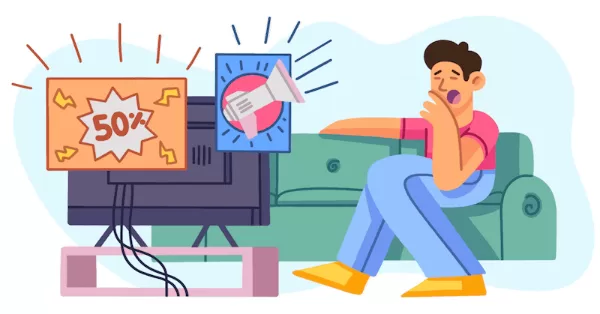
What is ad fatigue?
However, some brands fail to control their ad frequency, repeatedly showing the same content on official channels and through advertising partners. This excessive repetition of old messages causes target audiences to lose interest. This phenomenon is known as “ad fatigue.”
How To Spot Ad Fatigue In Ad Campaigns
You can detect Ad Fatigue when the performance metrics of your ad campaigns start to decline, even when your budget and frequency remain unchanged.
While platforms like Meta offer tools to help you identify this issue early, you should still understand the key metrics to proactively monitor and overcome ad fatigue before it harms your results. The most common signs include:
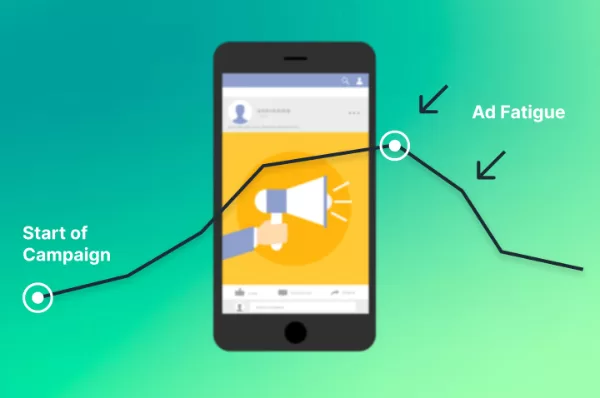
Warning signs that your ad campaign is hitting ad fatigue
Decreased Click-Through Rate (CTR)
This is a clear signal that your audience has seen your ads too often and is no longer interested. They scroll past without stopping, causing a significant drop in your CTR compared to the campaign’s average.
For example, a typical ad’s CTR of your brand is 3-5%, but it suddenly drops to 1% even though you haven’t changed the content or targeting.
Decreased Conversion Rate
Even if your ads still get clicks, users are no longer performing the desired actions like making a purchase, filling out a form, or signing up. This indicates your ad message is no longer compelling enough to persuade them.
To put it simply, if previously 5 out of every 100 ad clicks resulted in a purchase, now it’s only 1 or 2.
Increased Cost Per Action (CPA)
When both CTR and Conversion Rate decrease, the cost to acquire a conversion skyrockets. You have to spend significantly more to achieve the same results, leading to a serious waste of budget.
If you normally spend $10 to get one order, but now that number has increased to $20 or more, that’s a clear red flag.
Reduced Engagement
Worse yet, positive customer interactions like likes, comments, and shares start to decline, and you might even see negative comments. This is proof that your ads are becoming a nuisance to your audience.
When you notice that your company’s previous ad post received hundreds of likes and comments, but now it only gets a few dozen interactions. You need to act now if you don’t want platforms to reduce your brand’s reach.
All these signs lead to one common consequence: your campaign becomes ineffective and your budget goes to waste. That’s why the ability to overcome ad fatigue is not just a task, but a matter of survival for any marketer.
Why Does Overcome Ad Fatigue Matter To Marketers?
According to an early 2025 report by Optimove Insight, the biggest goal and top challenge for marketers is figuring out how to retain customers without overwhelming them with marketing messages.
Learning how to overcome ad fatigue plays a critical role here, especially in Email Marketing, which is considered the channel most likely to capture customer attention (48%, compared to Social Media Ads at just 23%). Paradoxically, it’s also the most likely to be seen as annoying (37%, versus 25% for Text Messages and 14% for Social Media Ads).
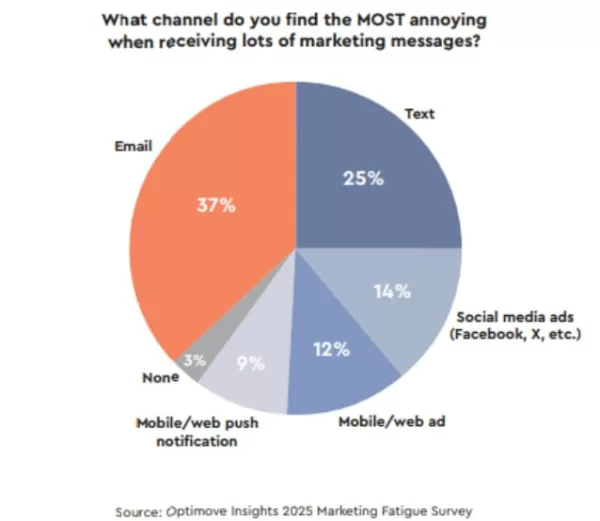
Survey results on which marketing channels people find most annoying
However, survey data shows that consumer reactions are fairly consistent across marketing channels, meaning no channel is completely “safe” from causing ad fatigue. Every customer touchpoint can be a double-edged sword if marketers don’t optimize content and frequency appropriately.
The consequences of ad fatigue are very clear: customers are willing to abandon a brand and switch to a competitor’s products or services simply because they feel “bombarded” by repetitive marketing messages. According to a consumer survey from Optimove Insight, up to 57% of respondents admitted to this, while only 7% felt that repetitive advertising had no effect on them.
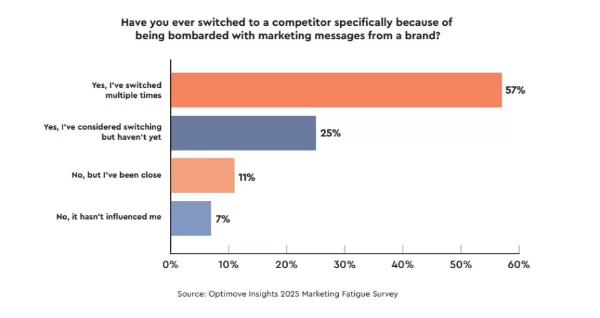
Survey results on consumers’ willingness to switch brands due to ad fatigue
From this, it is clear that ad fatigue is not just a minor issue; it is a serious risk that can lead to significant losses for a business if not managed in time. Businesses that act quickly to refresh their strategies are far more likely to overcome ad fatigue and protect long-term growth. So, what are the causes of this problem?
Causes Of Ad Fatigue That Marketers Should Pay Attention To
Ad fatigue does not develop overnight, rather, it is the result of a gradual buildup from repetitive messaging sustained over an extended period. It is primarily driven by a lack of fresh creative content and an overly aggressive ad frequency.
When viewers are exposed to the same content too often, particularly if it delivers no new value, they begin to ignore the ads or even form negative perceptions of the brand. To mitigate these risks, marketers must actively explore strategies to overcome ad fatigue and maintain audience engagement.
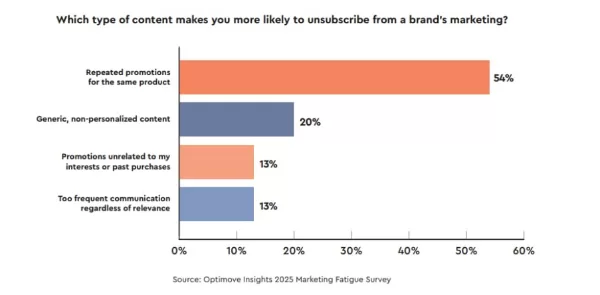
Survey results on content types that make consumers unfollow brands
According to the Optimove Insights 2025 Marketing Fatigue Survey, these are the common causes that every marketer should be aware of:
- Repetitive Creative Content: This is the leading cause, with 54% of consumers reporting that repeated promotions for the same product would make them unsubscribe from a brand’s marketing. This clearly shows that using the same images, headlines, or ad copy for an extended period is a serious risk.
- Lack of Personalization & Ignoring Audience Segmentation: These factors are also significant contributors. The survey found that 20% of consumers are likely to unsubscribe due to generic, non-personalized content, while another 13% do so because promotions are unrelated to their interests or past purchases. This highlights the importance of tailoring your messages to the right audience.
- Excessively High Ad Frequency: While a high frequency itself is a problem, it becomes a major issue when combined with repetitive creative. A small portion of respondents (13%) cited “too frequent communication regardless of relevance” as a reason to unsubscribe, reinforcing that bombarding customers with the same ad over and over will eventually lead to negative reactions.
Understanding these root causes is the first step toward building a more engaging, effective, and sustainable advertising strategy. By addressing them early, marketers can better position themselves to overcome ad fatigue and ensure long-term campaign success.
Effective Solutions to Overcome Ad Fatigue in 2025
Overcoming ad fatigue is not an easy challenge, but by applying the right strategies, you can maintain sustainable engagement with your customers. Here are the top solutions to help you refresh your ad campaigns, retain customers, and optimize business performance.
Refreshing Creative Content
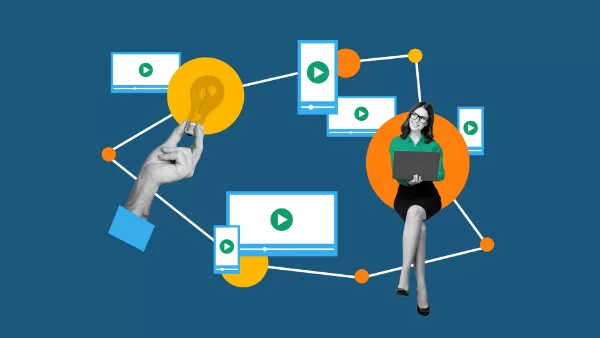
Refreshing creative content to keep ads engaging
Ad content is the core element viewers directly interact with. To avoid monotony, you need to continuously innovate both the messaging and the format.
When viewers start recognizing your content after the third or fourth time, they will tend to scroll past or skip it immediately. Therefore, preparing multiple creative variations is essential.
- Change Ad Formats: Make the most of platform-supported formats like images, short videos (Reels, Shorts), long-form videos, plain text posts, or Stories. With the same message, varying the way you present it will create a fresh feel for the audience.
- Change Layout, Colors, and Copy: Even when using the same core content, adjusting the layout, changing the color palette, or rewriting a small portion of the copy can make it difficult for viewers to immediately recognize a repetitive ad.
- Experiment with New CTAs: Instead of using a familiar call-to-action (CTA) like “Learn More,” you can try more powerful alternatives like “Shop Now” or “Discover Now” to create a sense of urgency and curiosity.
Optimizing Your Audience
This is an effective method to reduce ad frequency for a specific group of viewers. Modern advertising platforms like Facebook Ads, Google Ads, TikTok Ads, and LinkedIn Ads all support audience adjustments even while a campaign is running.
By refreshing your targeting strategy and avoiding the same customers who have already seen your ads many times, you create more opportunities to overcome ad fatigue and keep your campaigns effective. Instead of continuously targeting the same group of customers, you should:
- Expand Your Audience: Add new customer groups with similar interests, behaviors, or demographics. This helps your ads reach new people, reducing frequency pressure on the existing audience.
- Create Exclusion Audiences: Exclude people who have already converted (e.g., made a purchase or signed up) or who have engaged excessively without converting. This helps you focus your budget on more promising leads.
- Utilize Lookalike Audiences: Based on your existing customer list or people who have interacted with your ads, platforms will find individuals with similar behaviors. This is an efficient way to expand your potential customer base without “burning” your budget on repetitive ads.
Flexible Budget Allocation
Besides changing content and audience, flexible budget allocation is also a key to combating ad fatigue. Instead of sticking to a fixed budget for one campaign, you can:
- Redirect Your Budget: When you see a campaign showing signs of ad fatigue (e.g., rising CPA), shift the budget from that campaign to a new one or to another campaign that is performing better. This helps you avoid wasting money on ineffective ads.
- Use Automated Bid Strategies: Platforms like Google and Meta have powerful algorithms to automatically optimize ad delivery based on performance. By leveraging these features, you can ensure your ads reach the right people at the right time without requiring much manual intervention. This not only improves efficiency but also helps you overcome ad fatigue by keeping ad delivery relevant and timely.
Leverage Platform Optimization Features
Advertising platforms are increasingly developing smart algorithms to help you manage campaigns more effectively. Rather than just running ads manually, leveraging these features will help you alleviate the burden of ad fatigue.
- Optimize Ad Delivery: Most platforms have an automated feature that delivers ads to people most likely to interact and convert. This not only helps you reduce your CPA but also ensures ads are not shown repetitively in a meaningless way.
- Use Dynamic Ads: Dynamic ads automatically create hundreds of different ad variations from your product catalog. This allows each user to see a different ad version, reducing monotony and increasing personalization.
- Utilize “Frequency Caps”: Some platforms let you limit the number of times a user sees your ad within a specific period (e.g., no more than 3 times/day). This helps you control frequency and prevent ad fatigue from happening in the first place.
All of these tactics work toward a common goal: turning your ad campaigns from a budget-burning marathon into a smarter, more sustainable marketing strategy. At the end of the day, consistently refreshing your content and avoiding overload is the key to retaining customers and building a long-lasting, resilient brand.
FAQ: How Marketers Can Overcome Ad Fatigue and Boost Campaign Performance
What is ad fatigue?
Ad fatigue is the state where viewers become tired and apathetic towards ads when they are repeatedly exposed to the same message. It often occurs when brands fail to control ad frequency or use the same content for too long.
How do you spot the signs of ad fatigue?
You can recognize ad fatigue when key campaign metrics begin to decline, such as a drop in CTR and conversion rate, while CPA and ad frequency increase. Engagement (likes, comments) on your ad posts also decreases significantly.
What are the main causes of ad fatigue?
The leading cause is repetitive ad content (accounting for 54% of survey responses), combined with excessively high ad frequency. Additionally, a lack of personalization and poor audience segmentation are also major contributing factors.
What are some effective solutions to overcome ad fatigue?
You can apply strategies such as diversifying ad content, optimizing your audience by expanding to new customer groups and excluding those who have already engaged, and flexibly allocating your budget to campaigns that are performing better.
How can advertising platforms help overcome ad fatigue?
Platforms like Google and Meta offer many useful tools. You should leverage Dynamic Ads to create multiple variations, and use Frequency Caps to control the number of times a user sees your ad.
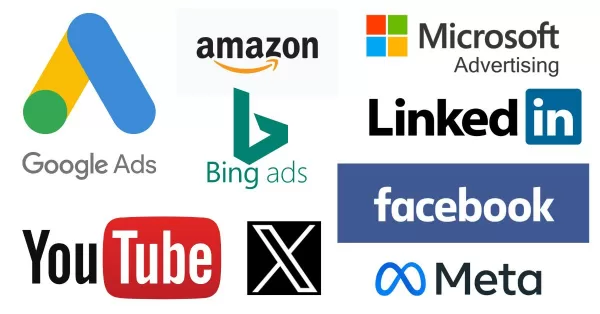
Some popular advertising platforms in 2025
Overcoming Ad Fatigue the Smart Way with On Digitals
When Ad Fatigue sets in, it’s not a sign of failure but a call to rethink your approach. By letting data guide your decisions, refreshing content regularly, and using budget more strategically, you create space for new ideas to thrive, and that’s how you truly overcome ad fatigue while strengthening long-term customer relationships.
At On Digitals, we understand this challenge and provide comprehensive solutions to help businesses build a smart, sustainable marketing strategy. With our team of seasoned experts, we don’t just help you analyze data to detect early signs of ad fatigue; we also create engaging, diverse content and optimize your budget to ensure every dollar spent on advertising yields the highest possible return.
NEWEST POSTS
- A Complete Guide to Programmatic Advertising for Digital Campaign Success
- A Complete Guide to Influencer Marketing ROI for Better Performance
- Account Based Marketing For B2B Teams Seeking Stronger Growth
- How To Spot Fake Followers On Influencer Profiles And Boost ROI
- Nano Vs micro influencers: Key differences And Best Uses
Read more
